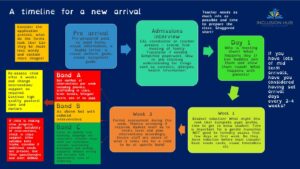
Why it’s crucial to know the English proficiency level of your students…
When I visit schools for consultancy or reviews I always ask schools what their percentage of EAL learners, most schools know this but then I ask what percentage of that figure are Band A, or Band B? This is where many schools fall down because not knowing this information accurately massively impacts how you will provide for your EAL cohort. For example a school with 80% EAL who has majority Band C-E students would have an entirely different challenge to a school with 80% EAL of which the majority were Band A and B. I am asked all the time about the best way to baseline assess EAL learners and then the best way to track and monitor progress. From a whole school perspective a comprehensive arrivals procedure and induction process is key for a smooth and gentle start to school for your EAL Learners. Understanding when it’s best to formally assess and which assessment works for your school is also key. Once you are aware of the levels of your EAL learners you can begin to plan staffing requirements for interventions and start ensuring staff are trained to understand both what levels the learners in their class are and what this LOOKS like from a teaching and learning point of view.
As part of a review I would usually look to help the school implement a flow chart for the arrival process which runs from pre-arrival to the end of the first term. A sample of this can be seen here:

As a teacher, it is essential to understand the level of English proficiency that your students have. Understanding your students’ language levels is crucial for effective teaching and learning, and it can help you to plan and deliver lessons that meet the needs of all students.
Here are some reasons why it is important to understand what level of English your students have:.
- Tailoring instruction to student needs: Students with different levels of English proficiency will require different levels of support and instruction. By understanding the level of English that each student has, teachers can tailor their instruction to meet the needs of each student, ensuring that they receive the appropriate level of challenge and support.
- Monitoring student progress: Understanding the level of English that your students have can also help you to monitor their progress over time. By assessing their language skills regularly, you can track their progress and identify areas where they may need additional support or intervention.
- Selecting appropriate materials: Choosing appropriate materials is crucial for effective teaching and learning. By understanding your students’ English proficiency levels, you can select materials that are appropriate for their language abilities, ensuring that they can engage with the content and learn effectively.
- Supporting language acquisition: English language acquisition is a complex process, and it is important to support students at each stage of their language development. By understanding the level of English that your students have, you can provide appropriate language input, support language production, and facilitate language practice.
- Building student confidence: Students who feel confident in their language abilities are more likely to participate actively in class, engage with the content, and learn effectively. By understanding your students’ language levels and providing appropriate support, you can help to build their confidence and promote their language development.
Knowing what the different levels look like is critical, jut looking at writing for example, the difference between a Band A or B *who would require intervention outside of the classroom) and a Band C (who would be scaffolded almost completely in the classroom) is stark:
Band A

Band B

Band C

If a teacher is aware of the differences between levels, then they can have an understanding of what is reasonably possible for children at each level and what will require considerably more support. But this starts at a whole school level and is the reason that effective assessment is required.
For further support with implementing a robust arrivals and induction process check out the Review service that Beth offers over on the CPD PAGE.
You can also take a look at our sister company EAL STAR for a new and amazing online EAL Assessment Platform.

